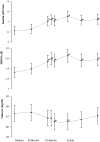Longitudinal study of insulin resistance and sex hormones over the menstrual cycle: the BioCycle Study
- PMID: 20843950
- PMCID: PMC2999972
- DOI: 10.1210/jc.2010-0702
Longitudinal study of insulin resistance and sex hormones over the menstrual cycle: the BioCycle Study
Abstract
Context: Conflicting findings have been reported regarding the effect of menstrual cycle phase and sex hormones on insulin sensitivity.
Objective: The aim was to determine the pattern of insulin resistance over the menstrual cycle and whether variations in sex hormones explain these patterns.
Design: The BioCycle study is a longitudinal study that measured hormones at different phases of the menstrual cycle. Participants had up to eight visits per cycle; each visit was timed using fertility monitors to capture sensitive windows of hormonal changes.
Setting: The study was conducted in the general community of the University at Buffalo (Buffalo, NY).
Participants: A total of 257 healthy, premenopausal women (age, 27±8 yr; body mass index, 24±4 kg/m2) participated in the study.
Main outcome measures: We measured fasting insulin, glucose, and insulin resistance by the homeostasis model of insulin resistance (HOMA-IR).
Results: Significant changes in HOMA-IR were observed over the menstrual cycle; from a midfollicular phase level of 1.35, levels rose to 1.59 during the early luteal phase and decreased to 1.55 in the late-luteal phase. HOMA-IR levels primarily reflected changes in insulin and not glucose. After adjustment for age, race, cycle, and other sex hormones, HOMA-IR was positively associated with estradiol (β=0.082; P<0.001) and progesterone (β=0.025; P<0.001), and inversely associated with FSH (adjusted β=-0.040; P<0.001) and SHBG (β=-0.085; P<0.001). LH was not associated with HOMA-IR. Further adjustment for BMI weakened the association with SHBG (β=-0.057; P=0.06) but did not affect other associations.
Conclusion: Insulin exhibited minor menstrual cycle variability. Estradiol and progesterone were positively associated with insulin resistance and should be considered in studies of insulin resistance among premenopausal women.
Figures
References
-
- Godsland IF 2005 Oestrogens and insulin secretion. Diabetologia 48:2213–2220 - PubMed
-
- Livingstone C, Collison M 2002 Sex steroids and insulin resistance. Clin Sci (Lond) 102:151–166 - PubMed
-
- Cagnacci A, Ferrari S, Tirelli A, Zanin R, Volpe A 2009 Insulin sensitivity and lipid metabolism with oral contraceptives containing chlormadinone acetate or desogestrel: a randomized trial. Contraception 79:111–116 - PubMed
-
- Widom B, Diamond MP, Simonson DC 1992 Alterations in glucose metabolism during menstrual cycle in women with IDDM. Diabetes Care 15:213–220 - PubMed
Publication types
MeSH terms
Substances
Grants and funding
LinkOut - more resources
Full Text Sources
Medical
Miscellaneous


